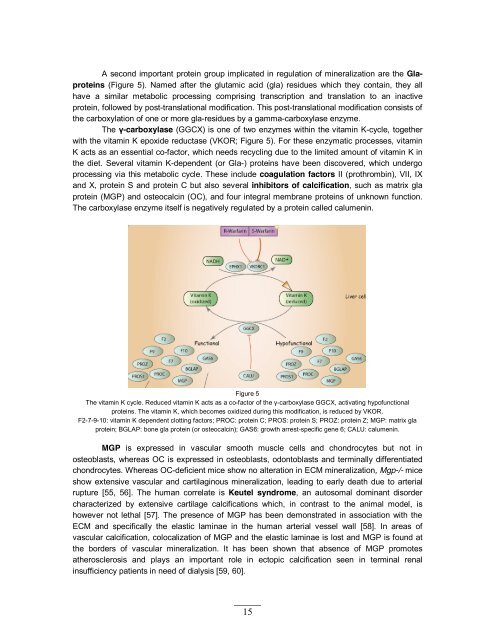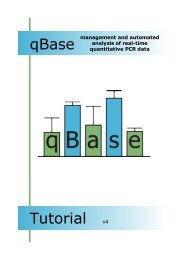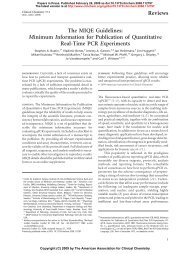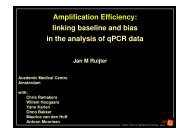This thesis is dedicated to my grandparents
This thesis is dedicated to my grandparents
This thesis is dedicated to my grandparents
You also want an ePaper? Increase the reach of your titles
YUMPU automatically turns print PDFs into web optimized ePapers that Google loves.
A second important protein group implicated in regulation of mineralization are the Glaproteins<br />
(Figure 5). Named after the glutamic acid (gla) residues which they contain, they all<br />
have a similar metabolic processing compr<strong>is</strong>ing transcription and translation <strong>to</strong> an inactive<br />
protein, followed by post-translational modification. <strong>Th<strong>is</strong></strong> post-translational modification cons<strong>is</strong>ts of<br />
the carboxylation of one or more gla-residues by a gamma-carboxylase enzyme.<br />
The γ-carboxylase (GGCX) <strong>is</strong> one of two enzymes within the vitamin K-cycle, <strong>to</strong>gether<br />
with the vitamin K epoxide reductase (VKOR; Figure 5). For these enzymatic processes, vitamin<br />
K acts as an essential co-fac<strong>to</strong>r, which needs recycling due <strong>to</strong> the limited amount of vitamin K in<br />
the diet. Several vitamin K-dependent (or Gla-) proteins have been d<strong>is</strong>covered, which undergo<br />
processing via th<strong>is</strong> metabolic cycle. These include coagulation fac<strong>to</strong>rs II (prothrombin), VII, IX<br />
and X, protein S and protein C but also several inhibi<strong>to</strong>rs of calcification, such as matrix gla<br />
protein (MGP) and osteocalcin (OC), and four integral membrane proteins of unknown function.<br />
The carboxylase enzyme itself <strong>is</strong> negatively regulated by a protein called calumenin.<br />
Figure 5<br />
The vitamin K cycle. Reduced vitamin K acts as a co-fac<strong>to</strong>r of the γ-carboxylase GGCX, activating hypofunctional<br />
proteins. The vitamin K, which becomes oxidized during th<strong>is</strong> modification, <strong>is</strong> reduced by VKOR.<br />
F2-7-9-10: vitamin K dependent clotting fac<strong>to</strong>rs; PROC: protein C; PROS: protein S; PROZ: protein Z; MGP: matrix gla<br />
protein; BGLAP: bone gla protein (or osteocalcin); GAS6: growth arrest-specific gene 6; CALU: calumenin.<br />
MGP <strong>is</strong> expressed in vascular smooth muscle cells and chondrocytes but not in<br />
osteoblasts, whereas OC <strong>is</strong> expressed in osteoblasts, odon<strong>to</strong>blasts and terminally differentiated<br />
chondrocytes. Whereas OC-deficient mice show no alteration in ECM mineralization, Mgp-/- mice<br />
show extensive vascular and cartilaginous mineralization, leading <strong>to</strong> early death due <strong>to</strong> arterial<br />
rupture [55, 56]. The human correlate <strong>is</strong> Keutel syndrome, an au<strong>to</strong>somal dominant d<strong>is</strong>order<br />
characterized by extensive cartilage calcifications which, in contrast <strong>to</strong> the animal model, <strong>is</strong><br />
however not lethal [57]. The presence of MGP has been demonstrated in association with the<br />
ECM and specifically the elastic laminae in the human arterial vessel wall [58]. In areas of<br />
vascular calcification, colocalization of MGP and the elastic laminae <strong>is</strong> lost and MGP <strong>is</strong> found at<br />
the borders of vascular mineralization. It has been shown that absence of MGP promotes<br />
atheroscleros<strong>is</strong> and plays an important role in ec<strong>to</strong>pic calcification seen in terminal renal<br />
insufficiency patients in need of dialys<strong>is</strong> [59, 60].<br />
15





